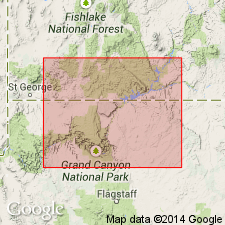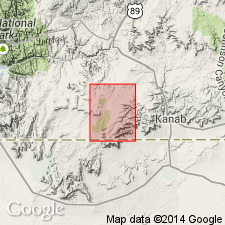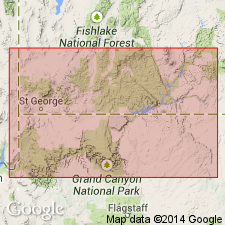
- Usage in publication:
-
- Lamb Point tongue*
- Modifications:
-
- First used
- Dominant lithology:
-
- Sandstone
- AAPG geologic province:
-
- Plateau sedimentary province
Summary:
First published use of Lamb Point tongue of Navajo sandstone of Glen Canyon group. [Name attributed to Wilson (in press) but that paper was never published. Type locality not discussed]. Used in the Kanab area, Kane Co, UT in the Plateau sedimentary province. Same rocks were assigned to the Wingate sandstone in earlier reports. Consists of grayish-white to grayish-orange, fine to very fine grained, cross-bedded sandstone. The crossbeds are large scale, large planar, wedge-shaped sets of high-angle tangential crossbeds that dip consistently southeast. Of eolian origin. Base of Lamb Point is about 300 ft above top of Springdale sandstone member of Moenave in the Kanab area. Is 400 ft thick in Kanab Canyon, 520 ft thick in Johnson Canyon to east in Kane Co. Coalesces with main body of Navajo farther east. Thins from 400 ft to 93 ft 10 mi southwest of Kanab. Just west of Sevier fault, vicinity of Moccasin, Coconino Co, AZ, sandstone grades into siltstone typical of Kayenta. Underlies Tenney Canyon tongue (first used) of Kayenta. Assigned a Jurassic and Jurassic? age. [No stratigraphic figures.]
Source: GNU records (USGS DDS-6; Denver GNULEX).

- Usage in publication:
-
- Lamb Point tongue*
- Modifications:
-
- Overview
- AAPG geologic province:
-
- Plateau sedimentary province
Summary:
Lamb Point tongue, a basal tongue of the Navajo sandstone, mapped along east side of quad, Kane Co, UT and northern Mohave Co, AZ, Plateau sedimentary province. Lamb Point overlies Kayenta formation and underlies Tenney Canyon tongue of Kayenta. Assigned a Jurassic? age. [See also MI-137.]
Source: GNU records (USGS DDS-6; Denver GNULEX).

- Usage in publication:
-
- Lamb Point Tongue*
- Modifications:
-
- Age modified
- AAPG geologic province:
-
- Plateau sedimentary province
Summary:
Age of Navajo Sandstone of Glen Canyon Group shown on a stratigraphic diagram as Pliensbachian and Toarcian, or Early Jurassic, rather than as Triassic? and Jurassic as previously assigned. Age modification of Navajo and hence of Lamb Point as a tongue of the Navajo based on identification of Early Jurassic palynomorphs in the older Whitmore Point Member of the Moenave Formation. [Age of Lamb Point, though name not used in this report, must also be Early Jurassic. Lamb Point mapped in the Kanab area, Kane Co, UT in the Plateau sedimentary province.]
Source: GNU records (USGS DDS-6; Denver GNULEX).
For more information, please contact Nancy Stamm, Geologic Names Committee Secretary.
Asterisk (*) indicates published by U.S. Geological Survey authors.
"No current usage" (†) implies that a name has been abandoned or has fallen into disuse. Former usage and, if known, replacement name given in parentheses ( ).
Slash (/) indicates name conflicts with nomenclatural guidelines (CSN, 1933; ACSN, 1961, 1970; NACSN, 1983, 2005, 2021). May be explained within brackets ([ ]).

